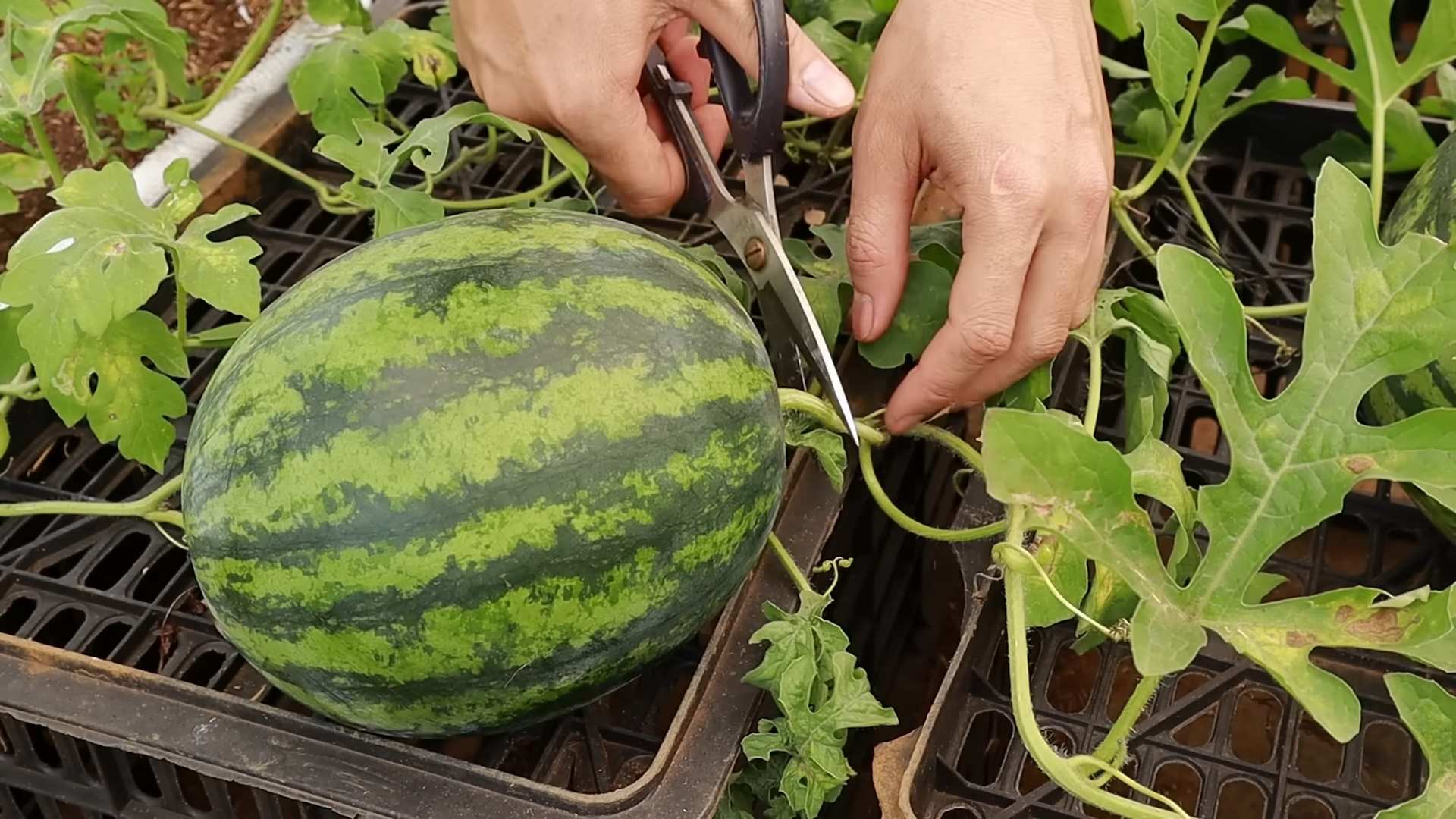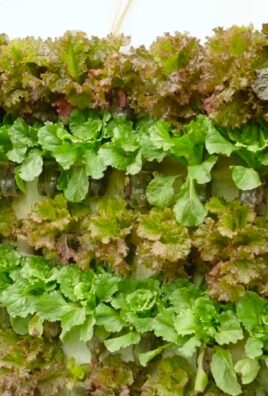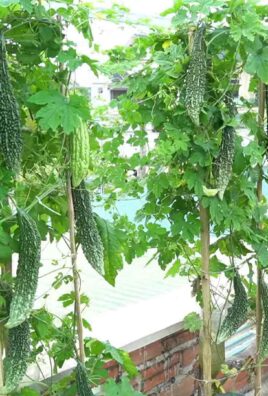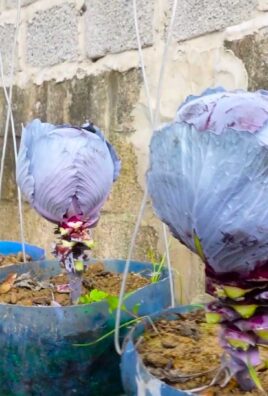Grow Watermelon at Home? Absolutely! Imagine biting into a juicy, sweet watermelon that you nurtured from seed to fruit, right in your own backyard. Forget those bland, store-bought watermelons – this summer, you can enjoy the unparalleled flavor of homegrown goodness. For centuries, watermelons have been a symbol of summer, abundance, and refreshing sweetness, enjoyed in cultures around the globe. From ancient Egypt, where they were depicted in hieroglyphics, to modern-day picnics, watermelons hold a special place in our hearts (and stomachs!).
But let’s be honest, the thought of growing your own watermelon can seem a little daunting. Many people believe you need acres of land and a green thumb blessed by the gardening gods. That’s where these DIY tricks and hacks come in! I’m here to show you that you don’t need a sprawling farm to grow watermelon at home. Whether you have a spacious garden or just a sunny balcony, I’ll share simple, effective techniques to help you cultivate your own delicious watermelons. These tips will save you time, money, and frustration, ensuring a bountiful harvest that will impress your friends and family. Get ready to roll up your sleeves and discover the secrets to growing the sweetest, most satisfying watermelons you’ve ever tasted!

Growing Watermelons: A Beginner’s Guide to Sweet Success!
Okay, so you want to grow watermelons at home? Awesome! It might seem intimidating, but trust me, with a little planning and effort, you can be enjoying your own homegrown, juicy watermelon before you know it. I’m going to walk you through everything you need to know, from choosing the right variety to harvesting your prize-winning melon. Let’s get started!
Choosing the Right Watermelon Variety
First things first, you need to pick a watermelon variety that suits your climate and garden size. Not all watermelons are created equal! Some are huge and need tons of space, while others are more compact and perfect for smaller gardens.
Here’s a breakdown of some popular varieties:
* ‘Sugar Baby’: This is a classic, early-maturing variety that produces small, round watermelons (around 8-10 pounds). It’s great for beginners and smaller gardens.
* ‘Crimson Sweet’: A popular choice for its sweet, red flesh and good disease resistance. It produces larger watermelons (around 15-25 pounds).
* ‘Jubilee’: An heirloom variety known for its elongated shape and sweet, juicy flavor. It can get quite large (25-40 pounds).
* ‘Bush Sugar Baby’: If space is really limited, this bush variety is your best bet. It produces smaller watermelons on compact vines.
* ‘Yellow Doll’: For something different, try this yellow-fleshed watermelon. It’s sweet and crisp, with a unique flavor.
Consider your growing season length. Some varieties need a longer growing season than others. Check the seed packet for the “days to maturity” and make sure it fits within your local climate.
Preparing Your Garden Bed
Watermelons are heavy feeders, meaning they need a lot of nutrients to thrive. So, preparing your garden bed properly is crucial.
* Sunlight: Watermelons need at least 6-8 hours of direct sunlight per day. Choose a location in your garden that gets plenty of sun.
* Soil: Watermelons prefer well-drained, sandy loam soil with a pH between 6.0 and 6.8.
* Soil Testing: It’s always a good idea to get your soil tested to determine its pH and nutrient levels. You can usually get a soil test done through your local agricultural extension office.
* Amending the Soil: Based on your soil test results, amend your soil with compost, well-rotted manure, or other organic matter to improve drainage, fertility, and water retention. I usually add a generous amount of compost to my watermelon bed.
* Raised Beds: If your soil is heavy clay or poorly drained, consider growing your watermelons in raised beds. This will improve drainage and prevent root rot.
Starting Watermelon Seeds
You can either direct sow watermelon seeds in your garden or start them indoors. Starting them indoors gives you a head start, especially if you have a short growing season.
Starting Seeds Indoors:
1. Timing: Start your seeds indoors about 3-4 weeks before the last expected frost in your area.
2. Containers: Use peat pots or biodegradable pots. Watermelons don’t like to have their roots disturbed, so these pots can be planted directly into the ground.
3. Potting Mix: Use a seed-starting mix that is light and well-draining.
4. Sowing: Plant 2-3 seeds per pot, about 1 inch deep.
5. Watering: Water gently to moisten the soil. Don’t overwater!
6. Warmth: Keep the pots in a warm location (around 70-80°F) until the seeds germinate. A heat mat can be helpful.
7. Light: Once the seeds germinate, provide plenty of light. A sunny windowsill or grow lights will work.
8. Thinning: Once the seedlings have a few true leaves, thin them to one plant per pot. Choose the strongest seedling and snip off the others at the soil line.
Direct Sowing Seeds:
1. Timing: Wait until the soil has warmed up to at least 70°F before direct sowing watermelon seeds.
2. Planting: Plant seeds about 1 inch deep and 2-3 feet apart.
3. Watering: Water gently to moisten the soil.
4. Protection: Protect the seedlings from pests and cold weather with row covers or cloches.
Transplanting Watermelon Seedlings
If you started your seeds indoors, it’s time to transplant them into your garden!
1. Hardening Off: Before transplanting, you need to harden off your seedlings. This means gradually exposing them to outdoor conditions over a period of 7-10 days. Start by placing them in a sheltered location for a few hours each day, gradually increasing the amount of time they spend outdoors.
2. Planting: Dig a hole that is slightly larger than the pot. Gently remove the seedling from the pot and place it in the hole. Make sure the top of the root ball is level with the soil surface.
3. Spacing: Space watermelon plants 2-3 feet apart, depending on the variety.
4. Watering: Water thoroughly after planting.
5. Mulching: Mulch around the plants with straw or other organic mulch to help retain moisture, suppress weeds, and regulate soil temperature.
Caring for Your Watermelon Plants
Now that your watermelon plants are in the ground, it’s time to give them the care they need to thrive.
* Watering: Watermelons need consistent moisture, especially during fruit development. Water deeply and regularly, but avoid overwatering, which can lead to root rot. Aim for about 1-2 inches of water per week.
* Fertilizing: Fertilize your watermelon plants every 2-3 weeks with a balanced fertilizer. You can also side-dress them with compost or well-rotted manure.
* Weeding: Keep the area around your watermelon plants free of weeds. Weeds compete with watermelons for nutrients and water.
* Pruning: Some people prune their watermelon vines to encourage larger fruit. You can prune off some of the side shoots, leaving the main vine and a few side shoots with developing watermelons. I personally don’t prune much, but it’s an option.
* Pollination: Watermelons need to be pollinated in order to produce fruit. Bees are the primary pollinators. If you don’t see many bees in your garden, you can hand-pollinate the flowers. To hand-pollinate, use a small paintbrush to transfer pollen from the male flowers to the female flowers. Female flowers have a small watermelon-like structure at the base of the flower.
* Pest and Disease Control: Keep an eye out for pests and diseases. Common watermelon pests include aphids, squash bugs, and cucumber beetles. Common diseases include powdery mildew and fusarium wilt. Use organic pest control methods and disease-resistant varieties to minimize problems.
Protecting Your Watermelons
As your watermelons grow, you may need to protect them from pests and diseases.
* Pest Control: Use row covers to protect young plants from pests. Handpick pests off of plants. Use insecticidal soap or neem oil to control aphids and other pests.
* Disease Control: Choose disease-resistant varieties. Provide good air circulation. Avoid overhead watering. Use copper fungicide or sulfur to control fungal diseases.
* Sunscald: Watermelons can get sunscald if they are exposed to too much direct sunlight. Protect them by shading them with shade cloth or by placing straw or other mulch over them.
* Ground Rot: To prevent ground rot, place a piece of cardboard or straw under each watermelon to keep it off the soil.
Harvesting Your Watermelons
This is the moment you’ve been waiting for! Knowing when to harvest your watermelons can be tricky, but here are a few signs to look for:
1. The tendril closest to the watermelon turns brown and dries up. This is a reliable indicator that the watermelon is ripe.
2. The bottom of the watermelon (where it rests on the ground) turns from white to yellow. This is called the “ground spot.”
3. The watermelon sounds hollow when you thump it. This takes some practice, but you’ll get the hang of it.
4. The rind becomes dull and less shiny.
Once you think your watermelon is ripe, use a sharp knife to cut it from the vine, leaving a few inches of stem attached.
Enjoying Your Homegrown Watermelon
Congratulations! You’ve successfully grown your own watermelon. Now it’s time to enjoy the fruits (or rather, the vegetables!) of your labor

Conclusion
So, there you have it! Growing watermelon at home might seem daunting at first, but with a little patience, the right techniques, and our simple guide, you’ll be sinking your teeth into juicy, homegrown watermelon before you know it. This isn’t just about saving money; it’s about experiencing the unparalleled satisfaction of nurturing a plant from seed to fruit, knowing exactly what went into its growth, and enjoying a flavor that store-bought watermelons simply can’t match.
Why is this DIY trick a must-try? Because it empowers you to control the quality of your food, reduces your carbon footprint by eliminating transportation, and provides a rewarding and educational experience for the whole family. Imagine the look on your children’s faces when they harvest a watermelon they helped grow! Plus, homegrown watermelons often boast superior flavor and sweetness compared to their commercially grown counterparts. You can choose varieties that are specifically suited to your taste and climate, something you rarely get the option to do at the grocery store.
Don’t be afraid to experiment! Try different watermelon varieties to find your favorite. Consider growing smaller, personal-sized watermelons if you have limited space. You can also explore companion planting to deter pests and improve soil health. Marigolds, for example, are known to repel nematodes, while basil can deter aphids and whiteflies.
And remember, success in gardening is often about learning from your mistakes. Don’t get discouraged if your first attempt isn’t perfect. Every season is a new opportunity to refine your techniques and improve your yield.
We wholeheartedly encourage you to give this DIY trick a try. The taste of success, in this case, is a sweet, refreshing slice of homegrown watermelon. We are confident that you will find the process rewarding and the results delicious.
Once you’ve harvested your first watermelon, we’d love to hear about your experience! Share your photos, tips, and challenges in the comments below. Let’s create a community of home gardeners who are passionate about growing their own food and enjoying the simple pleasures of life. Let us know what worked for you, what didn’t, and any variations you tried. Your feedback will help other aspiring watermelon growers and contribute to a collective knowledge base that benefits everyone. So, grab your seeds, prepare your soil, and get ready to embark on a rewarding journey of growing watermelon at home!
Frequently Asked Questions (FAQ)
What is the best time to start growing watermelon?
The ideal time to start growing watermelon depends on your climate. Watermelons are warm-weather crops and require a long growing season of at least 70-90 days. In general, you should start seeds indoors about 6-8 weeks before the last expected frost. If you live in a warmer climate with a longer growing season, you can direct sow seeds into the ground after the soil has warmed up to at least 70°F (21°C). Check your local frost dates to determine the best time to start your seeds.
What kind of soil is best for growing watermelon?
Watermelons thrive in well-drained, sandy loam soil that is rich in organic matter. The soil should have a pH between 6.0 and 6.8. Before planting, amend your soil with compost or well-rotted manure to improve its fertility and drainage. Avoid heavy clay soils, as they can retain too much moisture and lead to root rot. If you have clay soil, consider growing your watermelons in raised beds or containers.
How much sunlight do watermelons need?
Watermelons require at least 6-8 hours of direct sunlight per day to produce healthy vines and sweet, juicy fruits. Choose a planting location that receives full sun throughout the day. If you live in a particularly hot climate, some afternoon shade may be beneficial to prevent the vines from scorching.
How often should I water my watermelon plants?
Watermelons need consistent moisture, especially during the early stages of growth and when the fruits are developing. Water deeply and regularly, aiming to keep the soil consistently moist but not waterlogged. Avoid overhead watering, as this can promote fungal diseases. Instead, water at the base of the plants using a soaker hose or drip irrigation system. As the watermelons ripen, you can reduce watering slightly to concentrate the sugars in the fruit.
How do I know when my watermelon is ripe?
Determining when a watermelon is ripe can be tricky, but there are several indicators to look for:
* **The tendril closest to the fruit should be brown and dry.** This is often the most reliable sign.
* **The underside of the watermelon (where it rests on the ground) should be yellow or creamy in color.** This is known as the “ground spot.”
* **The watermelon should sound hollow when you thump it.** A dull thud indicates that the watermelon is not yet ripe.
* **The skin should be dull rather than shiny.**
It may take some practice to accurately determine ripeness, but with experience, you’ll get the hang of it.
What are some common pests and diseases that affect watermelons?
Watermelons can be susceptible to various pests and diseases, including:
* **Aphids:** These small insects suck sap from the leaves and can weaken the plants.
* **Cucumber beetles:** These beetles can damage the leaves and transmit diseases.
* **Squash vine borers:** These borers tunnel into the stems and can kill the plants.
* **Powdery mildew:** This fungal disease causes a white, powdery coating on the leaves.
* **Fusarium wilt:** This soilborne disease causes the plants to wilt and die.
To prevent pests and diseases, practice good garden hygiene, such as removing weeds and debris. You can also use organic pest control methods, such as insecticidal soap or neem oil. Choose disease-resistant watermelon varieties whenever possible.
Can I grow watermelon in a container?
Yes, you can grow watermelon in a container, but you’ll need a large container (at least 20 gallons) and a dwarf or bush variety of watermelon. Make sure the container has good drainage and use a high-quality potting mix. Water container-grown watermelons regularly and fertilize them every two weeks with a balanced fertilizer. You may also need to provide support for the vines as they grow.
How do I pollinate my watermelon plants?
Watermelons require pollination to produce fruit. If you don’t see bees or other pollinators in your garden, you may need to hand-pollinate your watermelon flowers. To hand-pollinate, use a small paintbrush to transfer pollen from the male flowers to the female flowers. Female flowers have a small, immature watermelon at the base of the flower, while male flowers do not. Pollinate the flowers in the morning, when the pollen is most viable.
What are some good companion plants for watermelons?
Companion planting can help deter pests, improve soil health, and enhance the growth of your watermelons. Some good companion plants for watermelons include:
* **Marigolds:** Repel nematodes and other soil pests.
* **Basil:** Deters aphids and whiteflies.
* **Nasturtiums:** Attract beneficial insects.
* **Radishes:** Repel cucumber beetles.
* **Oregano:** Provides ground cover and attracts beneficial insects.
How can I improve the sweetness of my watermelons?
Several factors can influence the sweetness of your watermelons, including:
* **Sunlight:** Watermelons need plenty of sunlight to produce sugars.
* **Water:** Avoid overwatering as the fruit ripens, as this can dilute the sugars.
* **Fertilizer:** Use a fertilizer that is high in potassium, which promotes fruit development and sweetness.
* **Variety:** Choose watermelon varieties that are known for their sweetness.
By following these tips, you can increase your chances of growing sweet and delicious watermelons at home.





Leave a Comment